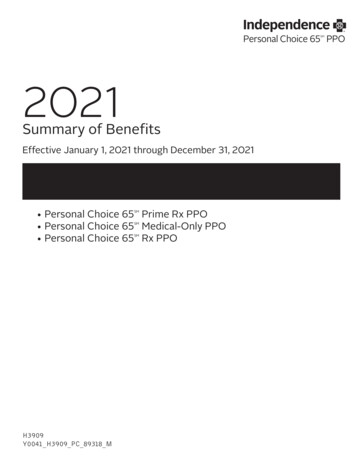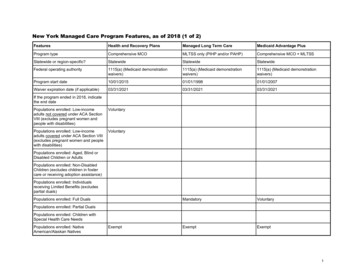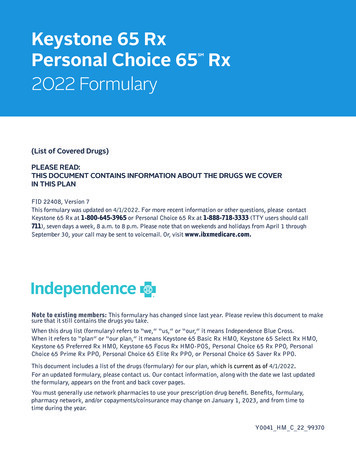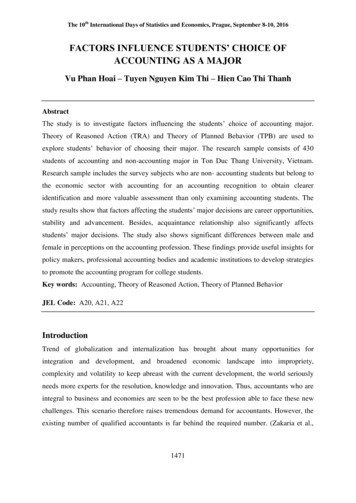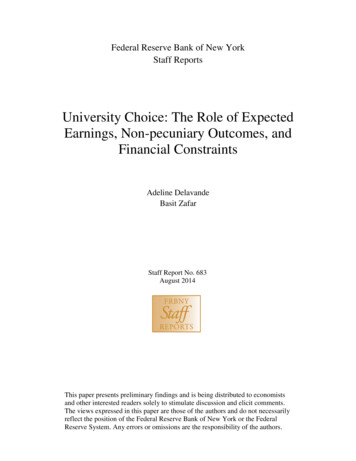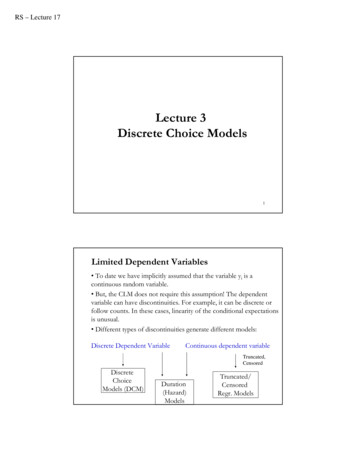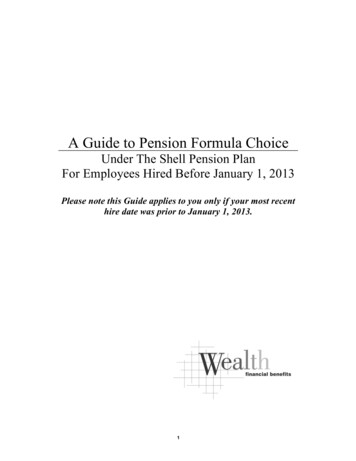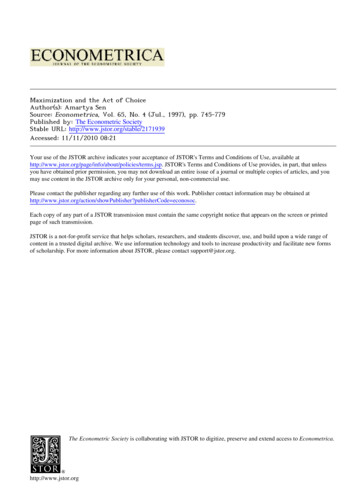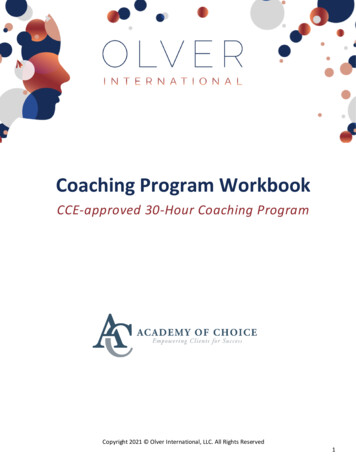
Transcription
Journal of Education & Social PolicyVol. 6, No. 2, June 2019doi:10.30845/jesp.v6n2p16Students Choice of a University: Case of the National University of Lesotho (NUL)Dr. Regina M. ThetsaneB.Ed. MBA. PhD Business AdminFaculty of Social SciencesNational University of Lesotho. 180. Lesotho.Dr. Motšelisi C. MokhethiB.Ed. MBA. PhD EntrepreneurshipFaculty of Social SciencesNational University of Lesotho. 180. Lesotho.Mr. Bukenya M. PatrickB. Com (Hons) ACMA, GCMA.Faculty of Social ScienceNational University of Lesotho. 180. LesothoAbstractThe study aimed at identifying factors that are perceived to be significant in choosing an institution is pivotal to informthe marketing approach for universities. The National University of Lesotho (NUL) was used as a study setting where asample consisted of 400 for the population size of 1758 was settled for and a stratified probability sampling techniqueused to select respondents. A total of 270 questionnaires were returned representing a response rate of 60%. Referencegroup was the top important factor that influences students’ choice of university, followed by institutional while theleast significant factor was media. The correlation results revealed strong association between and amongst the threefactors identified. Universities should be encouraged to match their offerings with the identified factors in order toincrease enrolment. They should pay attention to these factors and reflect on their recruitment and marketing strategiesto attract potential and retain existing students.Keywords: Universities, Student choice, Higher Education, First year Students.1. IntroductionIn recent years, Lesotho higher learning education landscape has gone through some changes. There has been somegrowth in the number of the Lesotho higher learning institutions, in particular the universities. This has been promptedby the entrance of two private universities in the higher learning institution sector in Lesotho in 2008 and 2015respectively. Since 1975 (NUL calendar, 1987-1988)to 2008, NUL has been enjoying the monopoly of being the onlyuniversity in the country. The entrance of the two private universities in the higher learning sector in Lesothointroduced choice for learners while triggering competition between and amongst universities and learners. Universitiescompete for high performing students while learners fight for a place in a better performing university.Campell (2000) argues that due to competitive environment amongst universities increased options for students tochoose from therefore, higher learning institutions need to behave strategically to attract students and raising theireducation quality, which have an impact on students‟ decision of choice of a university. Some of the new developmentsin the Lesotho higher learning sector include accreditation of higher learning institutions and declining funding ofhigher education by the Lesotho government. All these developments have impelled the recognition that a thoroughunderstanding of the factors influencing learners in choosing a university, especially the new entrants into theundergraduates programmes of the university is essential to guide marketing strategies meant to recruit students.Choosing a suitable university to apply to is an important decision for any students. It does not only affect students‟orientation of future career but also influences their motivation to study, commitment and interaction with theuniversity. In fact, not being rational in choosing a university, students may have difficulties in maintaining learningmotivation, achieving high academic results and getting a desirable job. Discovering factors which drive students‟choice of universities is, therefore, critical to inform the marketing strategies for any higher institution.140
ISSN 2375-0782 (Print) 2375-0790 (Online) Center for Promoting Ideas, USAwww.jespnet.comFurthermore, understanding factors impacting students‟ choice of university is the basis for recruiting strategies and theimplementation of relevant programs, which decides the survival and development of each university in the competitiveenvironment of higher education provision. In fact, Zhi-Hong, (2014) observed that the atmosphere of universityeducation has increasingly become competitive as a result universities have tocompete with each other to attractstudents in the recruitment markets. As competition in the higher education increases, universities are now faced withthe problem of competing for students to improve enrolment. Attempt to increase enrolment in this case calls for theapplication of the marketing concept. The marketing concept states that, in order to be successful, an institution mustidentify the needs and wants of specific target markets and deliver the desired satisfactions better than competitors(Schiffman & Kanuk 2010). By application, universities must identify the needs and wants of students in respect to themotivation factors that influence students‟ choice of a university in Lesotho. Therefore, it is very important foruniversities in Lesotho to pay attention to the competitive environment prevailing in the country, particularly, in thisera where universities are confronted with the decrease in the number of students (Matsolo, Ningpuany & Susuman,2016). Research shows that there are many factors that influence student‟s choice of a university. As Kusumawati,Yanamandram, and Perera (2010a) state that each factor has a different level of importance for every country and eachstudent. The current paper therefore, focuses on exploring significant factors which affects students‟ choice ofuniversity in Lesotho.The paper provides valuable information for higher learning institutions to be better aware of their students‟ needs andwants as customers so that appropriate marketing strategies can be designed to meet the needs of the students in orderto make them satisfied. It will also help to equip the educational policy makers of universities in formulating;implementing and modifying educational policy for the expansion of the higher education system in Lesotho.Specifically, this study answers the following questions: What factors influence choice of university among NULstudents? Which factors are perceived to be significant in their choice of NUL?2. Literature reviewA number of research has been done on factors influencing student‟s choice of university. These studies wereconducted based on economic, social and collective perspectives (Kim & Gasman, 2011). All these studies founddifferent factors that influence university choice in diverse context and locations. However, depending on the contextand circumstances, many researchers had found similar factors but the degree of importance varies (Maniu, I. & Maniu.G. 2015). Research on university choice factors has shown that there are common elements across nations and some ofsuch factors are: reputation of the institution, institutional location, availability of financial Aid /sponsorship, marketingfactors, personal factors, reference group and academic programme. However, they will differ depending on differentenvironment, context and countries.An institutional reputation is a core intangible asset of an institution and it creates barriers to competitive threats(Ravasi & Fombrun, 2004). A strong institutional reputation suggests that the products and services offered by theinstitution are of higher quality (Carmeli & Freund, 2005) and that the institution is responsible and will treat itscustomers well. As a result, institutional image has a powerful influence on making the decision to attend a university.Keling (2006) stated that the most influential factor that influences students in selecting a university is the reputation ofthe university. However, many studies have shown that proximity to home is one of the most important effects onchoice process (Alves & Raposo, 2007; Dawes & Brown, 2005), as some students may be looking for a university closeto their hometown or place of work for convenience and accessibility (Absher & Crawford, 1966). On the other,Hossler and Gallagher (1987) concluded that the proximity to a university affect attendance of students positively.Students who stay close to a campus are more likely to choose university though they may not attend the campuslocated near home (Ming, 2010). In a study of Ozdemir and Hacifazlioglu (2008) the majority of the participants statedthat the location of a university affected their decision on the choice of university.Financial assistance offered by universities is one of the most important attributes expected from a particular highereducation institution of choice (Yusof et al, 2008). It reduces the costs which are supposed to be borne by students.Thus, students who receive financial aid awards are more likely to enter universities, more so, in countries whereby therate of unemployment is high. Tamtekin (2015) observed that for some students the choice of an institution isconstrained by financial aspects and financial aid-scholarship can be necessary to expand their choice. However, Hoytand Brown (2003) argued that financial aid, scholarship, loans or grants are very important factors in making a choiceof university. Therefore, most of the universities attract potentially good students by offering financial benefits. Thisaffects the students‟ choices as they may then put more consideration into institutions with the most generous offer.Briggs (2006) argues that satisfaction of the needs of the students is of paramount importance for effective learning ofstudents. Therefore, marketing is necessary in education as it helps universities to provide the qualifications that satisfythe needs of the students.141
Journal of Education & Social PolicyVol. 6, No. 2, June 2019doi:10.30845/jesp.v6n2p16Marketing factors that include advertising, campus visits, career fairs and cost of university education have an influenceon the decisions of students to choose a university (Rudhumbu, 2017). Ming (2010) argued that advertising influencesstudent choice of a university, especially the social media, as research has shown that most of the youth spend most oftheir time on social media. Institutions can use the social media to build their institutional image and to create brandawareness amongst the youth, as they are their main target market. Briggs (2006) also emphasized the importance ofcampus visits, as one of the influencing choice factor. He indicated that the best way to find out about universities andthe courses they offer is to physically visit them. Other sources such as publications, television and media advertising,leaflets, newspaper and magazines are regarded as valuable, particularly for students in the rural areas who do not haveaccess to internet facilities (Maniu, I. & Maniu. G. 2015). Pampaloni (2010) emphasized the importance of internet andparticularly university website, student‟s social networks as very critical in influencing student‟s choice of university.Coccari and Javalgi (1995), Donnellan (2002), Holdsworth and Nind (2006), Shank, Quital and Taylor (2005) validatedthe importance of marketing factors on university choice process. Campus visits and open days provide the opportunityto talk to staff and students although, with thousands of students wandering round campuses, it may be difficult to meetand talk to the right people (Hoyt &Brown, 2003). Shank et al, (2005) maintained that an effective marketing helpsstudents create real expectations about what the universities offer and what commitment and involvement is neededwithout having unreal expectations and promises about offers which cannot be kept. It is important for institutions tounderstand what attracts the prospect students in a university compared to another and ensure that those expectationsare met. However, Price et al, (2003) argue that the most influencing factor in choosing an institution is non-marketing,such as, parents and friends. Conversely, Bergerson (2009) cited cost of university as one of the most influencinginstitutional attribute in choosing a university. Before making any choice, students estimate how much money they willhave to spend on a good education. According to Tamtekin (2015) it does not only mean university fees but alsoincludes accommodation, food and transportation costs.Age, gender, family background, occupation, socio- economic circumstances and lifestyle are considered as personalfactors influencing the choice of university. Before choosing a university students go through three decision setsnamely: student‟s awareness set, consideration set and choice set (Dawes & Brown, 2005). Personal preference is themost critical influential factor in university selection in Turkish students (Yamamoto, 2006). Alternatively, Wargnerand Fard (2009) argued that socio-economic circumstances of the family, especially financial resources are one of themost influential factor in choosing a university to attend. Nonetheless, Avery and Hoxby (2004) observed that studentswho have higher socio-economic background with strong financial resource and whose parents had earned a bachelordegree do not put financial support from the university on top priority. Depending on circumstances and countriespersonal factors have the most positive influence on student‟s choice of a university (Raposo & Alves, 2007).A reference group refers to a group of people we compare ourselves to for information regarding behavior, attitudes orvalues (Hoyer & MacInnis, 2001). Lamb, Hair, McDaniel, 2002) argue that reference groups can either be direct orindirect. The direct reference groups touch people‟s life directly, for instance, parents, siblings, friends and teachers. Assuch, they can influence psychological core and the process of making decisions by affecting who we get informationfrom and how we evaluate it. Direct reference groups influence people to behave and make the decision in a certainway. Among those who have influence on student‟s choice of university parents and siblings are considered the mostimportant ones (Briggs 2006), as they do not act as reference but provide financial commitment and support for theirchildren. As a result, financial support from one‟s family might result in limitation of one‟s decisions concerning one‟sacademic future (Pimpa, 2004). In support of Pimpa (2004), Murphy (1981) observed that most students perceive theirparents to be the most influencing factor to their choice, especially in terms of financial support.In contrast, Issac, Malaney and Karra (1992) found the relationship between parent‟s educational background andstudent choice in that male student‟s decision are mostly affected by their father education than their mothers. In somestudies, the reference group includes siblings, friends, relatives, teachers and other people that play an important role instudent life (Kusumawati, Yanamandran and Perera, 2010b). This was supported by Kim and Gasman (2011), Avinashand Babli (2017) who argued that friends, peers and teachers have a major role in influencing student‟s choice ofuniversity. Moreover, the results of Fletcher‟s study (2012) are similar with those of Pimpa (2005) who argued thatstudents are influenced by their peers in selecting a university to attend. Commonly, reference groups influenceuniversity choice decision of students but they do not have any limitation related to their choice that has a great effecton their life (Tamtekin, 2015). Parents, teachers, peers, siblings‟ relatives can only make suggestions but do not imposeany obligation (Raposo & Alves, 2007). Availability of required academic programme was cited as the very importantattributes for the first year university students to choose a particular higher education institution (Yusof et al, 2008).Keling, Krishnan and Nurtjahja (2007) surveyed institution and found students placed the highest importance on factorsregarding program of study, tuition cost, financial aid, and job placement when selecting a college.142
ISSN 2375-0782 (Print) 2375-0790 (Online) Center for Promoting Ideas, USAwww.jespnet.comNurlida et al, (2010) concede that the more the attributes meet the expectations of students based on informationgathered, the higher the enrolment at the university. Students evaluate programmes based on: selection of courses,availability of courses and entry requirements; quality and variety of education (Shanka, Quintal and Taylor, 2005); andquality and flexibility of degree/course combinations (Holdsworth & Nind, 2006).3. MethodologyThe research design for this paper is descriptive due to the fact that the study seeks to identify the factors that influencestudents‟ choice of the university in Lesotho. The target population was composed of all first year students of NUL inthe academic year 2017/2018. Sekaran and Bougie‟s (2013) table of sample size was used and a sample of 400 for thepopulation size of 1788 was adopted. Stratified probability sampling was used to select students from the seven NULfaculties and within each strata (faculty) simple sampling technique was used to select students from each faculty(Table 1.1).A self-developed questionnaire was of three sections. Section A was designed to collect demographic data of thestudents. B concentrated on the values and goals of the students. Part C concentrated on the factors that influence therespondents‟ choice of university and utilizes 5 point Likert-scale where respondents were required to indicate theirresponse between two extreme points, thus, high importance and not very important. The last part was centered onother significant factors influencing students „choice of university‟. The questionnaire was administered in the firstsemester of the university after the students had registered in the academic year 2018/19. 270 questionnaires werereturned and authenticated representing a response rate of 60%. The Statistical Package for Social Sciences(SPSS)program was used to analyze the data using factor analysis with principal component extraction and correlation analysisto determine the relationship between the factors that affect the student‟s university choice.4. Findings of the studyAs far as the students‟ gender is concerned, male students accounted for39% of the total sample while female studentswas 61%. The results are consistent with NUL overall statistics enrolment (2018/19) by gender whereby females‟students account for a larger percentage (63%) than males with (37%) (NUL Statistics enrolment by gender academicyear 2018/19). Again, majority of the respondents in this study constituting 82% were between the ages 18-23, while12% were above 23 and 6% were below18 years. The results indicate that the average age of NUL first year student‟sfall between 18-23 years.4.1 Factor analysisTo identify the factors that influence student‟s choice of university and to determine construct validity of the instrumentan exploratory factor analysis was performed. The factor analysis produced 3 factors (Table 1.2). Factor 1 is named,media influence (made up of 5 variables) factor 2 is institutional related influence (made up of 3 variables) and factor3is direct reference group (made up of 4 variables). Two items of the eighteen variables were eliminated because theyboth loaded in more than one factor. This result shows the importance of the three factors in choosing an institution ofstudy. Cronbach‟s alpha coefficients, estimating internal consistency of each factor were calculated as α 0.91 formedia influence, α 0.89 for university related influence, α 0.70 for direct reference group (Table 1.3). An alphacoefficient of 0.7 is considered and indicates high reliability of the measuring scale (Pietersen & Maree 2016; Cohen,Manion & Morrison, 2007). All these coefficients are in the range that suggests high reliability of the measuring scale,therefore the instrument used is reliable.4.2 Descriptive resultsThe findings of descriptive statistics of the factors affecting students' university choice are given in Table1.4.Mean(x̅)and standard deviation were used to describe the importance of factors that affect students‟ university choice.As it can be seen from Table 1.3, when the descriptive statistics of the factors affecting university students' choice areexamined, it is seen that while the most important factors affecting students' choice are “Direct reference groupsinfluence” (x̅ 3.62) followed by “Institutional related influence” (x̅ 3,25); the least important factor is “Media relatedinfluence” (x̅ 2,73). The results show that direct reference group (fathers, mothers, teachers and friends) has a majorimpact in influencing students‟ choice of university. It affects student‟s choice of an institution more directly than mostother social influences on consumer decision making.4.3 T-test resultsThe results of the t-test analysis on the comparison of the importance given to the factors influencing the choice ofuniversity are given in Table 1.5. As shown in Table1.5, there are significant differences in three variables (Media–Institutional and Reference) that influence student‟s choice of university . The influence of reference group (x̅ 3.62)was significantly greater than the influence of institutional (x̅ 3. 25), t (157) 0.4205, p 0.01).143
Journal of Education & Social PolicyVol. 6, No. 2, June 2019doi:10.30845/jesp.v6n2p16Similarly, the influence of reference group (x̅ 3.62) was significantly greater than the influence of media (x̅ 2, 73), t(155) 10.021, p 0.01). The same result was found where students give more importance to institutional variable (x̅ 3, 25), than media variable (x̅ 2.73), t (179) 0.4808, p 0.01) in choosing a university of study.4.4 Correlation resultsTable 1.6 presents the results of correlation analysis to determine the relationship between the three factors that affectthe student‟s university choice. As can be seen from Table 1.6, the correlation results show a significant positiverelationship between the influence of media with the influence of the university related factor (r 0.576, p 0.01) inchoosing university of study. There is also a significant relationship between the influence of direct reference groupwith university related factors influencing student‟s choice of university (r 0.391, p 0.01). The direct referencegroups have a positive and significant relationship to media related factors (r 0.529, p 0.01).5. Conclusion of findingsWhile the study was limited in scope to NUL first year‟s students in Lesotho, the results may show factors whichextend beyond Lesotho. The findings of this study revealed a number of factors influencing student‟s choice ofuniversity; however, such factors differ in terms of their degree of importance in choosing a university to attend. Thesefactors are group into three main categories, namely: Direct reference group, Institutional and Media related factors.5.1 Direct reference group factorDirect reference group (fathers, mother‟s friends, peers, teachers and siblings) was found to bethe most influentialfactor in choosing an institution in Lesotho. Parents, in particular serve as a major influence in their children‟s careerdevelopment and career decision-making and one factor which influences happiness and success is the right universitychoice (Keller 2004). Bregman and Killen (1999) discovered that students value parental influence and guidance in thearea of an institutional choice, as they pay much attention to what parents expect of them, particularly in choosing auniversity. Therefore, parents‟ financial concerns and expectations play a part in their direct or indirect influence ontheir children‟s university choice by adding their own biases and attitudes into particular occupational fields (Clutter,2010). Briggs (2006) also contended that high school teachers are universities‟ utmost allies in assisting students‟decision making about the choice of university.However, Price et al, (2003) argued that parents, friends and teachers are mainly influential in choosing a program andnot university. Unlike, Price et al, (2003) this research demonstrates that parents, friends, teachers and siblings have amajor significant influence in choosing a university to attend. This can be attributed to the fact that in Lesotho there is astronger close relationship between parents and children. On the other hand, it might be that probably majority ofLesotho parents are only familiar with NUL, which is the oldest university in Lesotho. Thus, the reason why they don‟tmake an effort to search for other alternatives. The results of this study is also consistent with Maniu, I.and Maniu, G.(2015), Perna (2006) and Al Yousef (2009) who concluded that the recommendations that come from families, peers,friends, teachers and reference groups have a strong influence and considered trustworthy in choosing a university toattend.5.2 Institutional factorThe second factor that was found to be influential was the factor related to institution (university posters, universitywebsites, university internet, university radios, newspapers and local radios). These are methods of getting informationabout the university. They are related to how an institutions market themselves and provide information for students tomake informed decision in choosing a university to attend. The internet, especially the university websites were cited asthe most influential factor in selecting an institution to attend (Pampaloni, 2010, Kim & Gasman, 2011).These resultsare confirmed by Ariffin et al (2008) and also Keling, Krishnan and Nurtjahja (2007) who found that universitywebsites and newspapers were influential in selecting an institution to attend while a study by Ismail (2009) and Keling(2006) found that institutional image and reputation, had a high explanatory power on how students decide on whichuniversity to study at (Pampaloni, 2010). Internet, university websites, social networks and mailed brochures are veryimportant and influential in choosing a university to attend (Fischbach, 2006). However, Maniu, I. and Maniu, G.(2015) emphasized that universities websites should be easy to navigate and include correct and targeted informationwritten for prospective and current students with videos displaying students‟ experience of the university.5.3 Media related factorThe least significant factor among the three that were studied is the Media related factor (the university visits to highschools, visits by university representatives and carrier fairs organized by Council on Higher Education in Lesotho).Kim and Gasman (2011) emphasized the importance of schools visits by university representatives, visits to campuses,open doors days in choosing an institution to attend.144
ISSN 2375-0782 (Print) 2375-0790 (Online) Center for Promoting Ideas, USAwww.jespnet.comVisits to high schools by university representatives were rated as an extremely effective influencer in choosinguniversity to attend (Lay & Maguire, 1981). The same results were found by Hossler, Schmit and Vesper (1999) whoalso argued that university visits can be very conducive and beneficial for both students and institutions by not onlyadvertising but also giving some information about their facilities. Other media factors, such as, television, newspapersand magazines, media advertising (not written by the institution) are used by institutions to place advertisements thatinclude information on education, social facilities and contact information (Osoro, Amundson, & Borgen, 2000; Hoyt,Brown, & BJL, 2003) and as a result they have great influence on the choice of university to study.6. ConclusionIn conclusion, there is a positive relationship between and amongst the three factors identified as the main influentialfactors in choosing a university to attend. Therefore, the results and findings of this study may provide institutions,colleges and educational marketers with some insight into the factors to pay attention to when it comes to marketingtheir institutions. Given the current setting of higher learning sector in Lesotho, institutions are also encouraged tomatch their offerings with the identified factors that influence student‟s choice of university in order to increaseenrolment. Lastly, universities should pay special attention to these important factors and reflect on their recruitmentand marketing strategies to attract potential and retain existing students.Table 1.1: Number of 1st year students admitted in 2018/19 per faculty.FacultiesNo of first year studentsadmitted per faculty –2018/2019Faculty of AgricultureFaculty of EducationFaculty of Health ScienceFaculty of Science and TechnologyFaculty of HumanitiesFaculty of LawFaculty of Social SciencesTOTALSSample size in each Table 1.2: Exploratory Factor analysis resultsLocal radiosNewspapersUniversity radiosUniversity postersUniversity websitesUniversity RepresentativesUniversity Visits to my schoolVisits to career fair organized by CHEInfluence by motherInfluence by FatherInfluence by teachersInfluence by FriendsExtraction Method: Principal Component Analysis.Rotation Method: Varimax with Kaiser Normalization.a. Rotation converged in 6 rsInstitutionalinfluenceDirect referenceinfluence.830.806.780.794.664.635.569145
Journal of Education & Social PolicyVol. 6, No. 2, June 2019doi:10.30845/jesp.v6n2p16Table 1.3: Cronbach’s alpha reliability coefficientCronbach’s Alpha0.910.890.70VariablesMedia influenceInstitutional related influenceDirect reference groupsNumber of items534Table 1:4 Descriptive statistics on media, institutional and direct referenceMean ( x̅ )FactorsStd. deviationMedia related influence2.73.13Institutional related influence3.25.13Direct reference groups3.62.84VariablesTable 1.5 Paired Samples TestPaired DifferencesMeanSDSE95% ConfidenceInterval of theDifferenceLowerUppertdfSig.Pair 1M
A number of research has been done on factors influencing student‟s choice of university. These studies were conducted based on economic, social and collective perspectives (Kim & Gasman, 2011). All these studies found different factors that influence university choice in diverse context and locations. However, depending on the context
